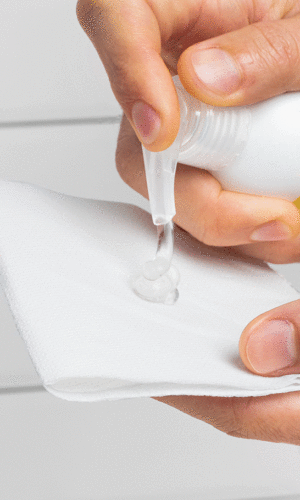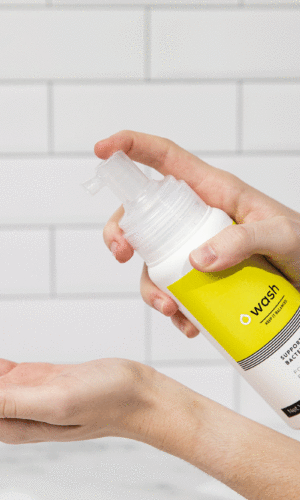
Lactoferrin is a protein found in the milk of mammals. It is commonly derived from cow’s milk and colostrum (the first milk produced after a cow gives birth) for use in cosmetics and medical products. Lactoferrin is also present in human milk and some mucosal fluids like tears, saliva, and nasal secretions, so we naturally have it in our bodies.
Lactoferrin is multifunctional:
- Binds to iron and transports it;
- Has antimicrobial, anti-inflammatory, and antioxidant activity;
- Boosts immune system;
- Has prebiotic properties.
Often referred to as “pink gold,” lactoferrin has a pinkish color as it is rich in iron. The “gold” alludes to its high cost because the content of lactoferrin in milk is low, resulting in expensive production.
Lactoferrin is often recommended for those with iron deficiency. It binds to iron in the digestive system and ensures its efficient absorption in the intestines. This makes lactoferrin a great supplement for individuals with iron deficiency, ensuring that the body gets the required iron without promoting the growth of pathogenic bacteria.
Lactoferrin is considered a useful supplement when there is an increased risk of genital tract infections, like during antibiotic therapy, anti-inflammatory treatment with steroids, chronic stress, and before gynecological surgery.
Lactoferrin for healthy microbiome.
The microbiome is a community of microorganisms that inhabit our bodies: gut, skin, ears, eyes, etc. The microbial balance plays a crucial role in immunity and overall health.
Lactoferrin is extremely effective in supporting a healthy microbiome, as it limits the growth of harmful bacteria and supports beneficial bacteria. It works against pathogenic bacteria in three ways:
1. Deprives bacteria of free iron that they need to grow.
2. Damages bacterial cell membranes.
3. Breaks and prevents bacterial biofilms.
Many cells in our bodies, including those in the gut, blood, and liver, have lactoferrin receptors. They allow lactoferrin to bind to those cells and do its job: from iron transport to immune regulation.
Many harmful bacteria also have lactoferrin receptors which allows lactoferrin to stick to them and cause damage.
But how does it target pathogenic bacteria, but doesn’t harm beneficial ones?
Lactoferrin has a selective antimicrobial potency, being more effective against pathogenic bacteria. It suppresses the growth of harmful bacteria, which creates an environment where good bacteria can overgrow. Beneficial bacteria do not rely on free iron as much – they have different ways of getting their “food”.
Apart from its direct interactions with microbes, lactoferrin modulates immune cell functions. By supporting a balanced immune response, lactoferrin helps maintain a harmonious relationship between the host and its resident beneficial microbes.
So although it has antimicrobial action, lactoferrin doesn’t kill good bacteria.
Lactoferrin for biofilm removal.
Biofilms are communities of microorganisms adhering to a surface. In biofilms, bacterial cells are enclosed in a self-produced matrix, which makes them highly resistant to treatments (including antibiotics) and the body’s natural defense mechanisms. Thus, traditional treatments often fail against biofilms. This is because bacteria within biofilms have a different metabolic profile than free-living bacteria and are better shielded against antibiotics.
Enter lactoferrin. The lactoferrin-derived peptides, lactoferrampin and lactoferricin, disrupt bacterial membranes, making biofilms fall apart.
Iron also plays a crucial role in biofilm development and growth. Bacteria use siderophores to grab iron from the environment. Lactoferrin’s unique ability to bind and sequester iron deprives the biofilm of this essential nutrient. Lactoferrin also interacts with bacterial membranes, causing membrane damage and inhibiting essential bacterial functions.
As a result, lactoferrin makes the biofilm community weaker, and it eventually falls apart and can be treated effectively.
Lactoferrin: an alternative to antibiotics?
Given the rise of antibiotic-resistant bacterial strains, lactoferrin and its derivatives are studied as potential alternative antibiotics. Studies show, that lactoferrin-based therapies can be effective against a range of infections, including those resistant to traditional antibiotics.
For example, over the years, the use of antibiotics, specifically quinolones, to treat UTIs has led to a significant increase in antibiotic-resistant E. coli strains.
Lactoferricin B (Lfcin B) – a peptide of bovine lactoferrin – has shown antimicrobial properties against E. coli, which are responsible for 90% of UTIs worldwide.
The action of Lfcin B is based on interacting with bacterial membranes, leading to their disruption and bacterial cell death. Thus lactoferrin also disrupts E. coli biofilms, which boosts the efficacy of antibiotics, making bacteria more susceptible to them. Learn more in this blog.
As of now, lactoferrin can’t replace antibiotics. However, studies show that it can be a great supplement taken along with antibiotic treatment.
Lactoferrin undoubtedly garnered our attention. Its benefits seem endless: boosts immunity, helps with chronic infections, kills antibiotic-resistant bacteria, improves gut health, cycle regularity, intimate health, skin, hair, nails… and the list goes on.
As we’re truly impressed with this ingredient, we decided to add lactoferrin to one of our novel products: Intimate SERUM and Suppositories. The main function of SERUM is to make you smell Fresh Down There by promoting healthy flora. However, due to the combination of such ingredients as lactoferrin, xylitol, saccharomyces ferment, and prebiotics, Intimate SERUM offers additional benefits.
Let’s see how lactoferrin can help with intimate odor.
Lactoferrin for yeast infections.
Yeast infections, particularly those caused by Candida albicans, can be challenging, especially given they can also form biofilms. Lactoferrin binds directly to the surface of the yeast cell membrane, disrupting the integrity and function of the cell membrane and leading to cell death.
Within this study, lactoferrin demonstrated antifungal activity against Candida and showed enhanced activity in combination with the three antifungals tested against Candida’s growth. The combination of lactoferrin and fluconazole was particularly successful.
Lactoferrin for BV.
A common issue many women experience is bacterial vaginosis, often caused by a pH imbalance in the vagina and overgrowth of harmful bacteria.
This is how lactoferrin can help combat bacteria responsible for BV, such as Gardnerella vaginalis:
1. It starves bacteria by depriving them of iron needed for their growth, inhibits their colonization, and can lead to a reduction in infection.
2. It damages the cellular structure of bacteria, leading to their death.
3. It prevents and breaks bacterial biofilms. Lactoferrin exposes the bacteria, making them more vulnerable to antibiotics and the host’s immune system.
4. It boosts immunity, preventing bacterial imbalance in the first place.
By targeting these bacteria, lactoferrin also helps restore the natural acidic pH of the vagina, promoting a healthier environment and preventing infections.
Lactoferrin to smell Fresh Down There.
Intimane odor in men and women can be a result of bacterial vaginosis, yeast infections, or other microbial imbalances in the genital environment. If you experience a strong intimate odor and discomfort, please, see a doctor and get the treatment if needed.
However, sometimes the tests are fine, but you still smell yourself through your pants and feel that itch. Intimate SERUM was just made for cases like that.
Lactoferrin in SERUM removes food for odor-causing bacteria, damages bacterial cells, and breaks bacterial biofilms. This, and lactoferrin’s prebiotic properties, allows your healthy bacteria to overgrow pathogenic ones, your flora goes back to balance, and you have no odor.
Lactoferrin also works wonders in combination with other anti-microbial compounds, like xylitol, which we also added to the formula of Intimate SERUM. Xylitol is a sugar alcohol that inhibits the growth of bacteria and yeast. “Thinking” it is a regular sugar, bacteria consume xylitol but can’t metabolize it, so they starve.
When used together, lactoferrin and xylitol offer a potent defense against various pathogens.
Additionally, Intimate SERUM contains prebiotics, which are food for beneficial bacteria, and saccharomyces ferment, which sticks to odor molecules and doesn’t allow them to evaporate from the skin and cause odor.
Summary:
1. Lactoferrin is naturally found in our bodies’ fluids and in mammals’ milk.
2. Lactoferrin is a multifunctional protein: it has antimicrobial and antifungal properties, binds to iron and transports it, and boosts immunity.
3. Lactoferrin supports a healthy microbiome by inhibiting harmful bacteria, breaking bacterial biofilms, and allowing beneficial bacteria to grow.
4. Lactoferrin enhances the efficacy of antibiotics, especially against antibiotic-resistant bacteria.
5. Intimate SERUM with 4% lactoferrin combats intimate odor by disrupting bacterial activity, promoting healthy flora, and working in combination with xylitol, prebiotics, and saccharomyces ferment.
-
CREAM: Stop Body Odor
$11.00 — or$11.00Original price was: $11.00.$8.80Current price is: $8.80. every 3 months Add to cartAcidify your way to smooth and odorless armpits and groin.
-
WipeGel: Turn TP into wipes
$21.99 — or$21.99Original price was: $21.99.$17.59Current price is: $17.59. every 3 months Add to cartWipeGel: Gives ordinary toilet paper prebiotic superpowers.
-
WASH: Support Healthy Flora
$19.00 — or$19.00Original price was: $19.00.$15.20Current price is: $15.20. every 3 months Add to cartWASH: Purely designed to defend the body’s natural defenses.





